There are many more owl species in Texas than just the common Great Horned Owl. These owls vary not just in size, but also coloration and overall appearance, diet, and what habitat they prefer. They make an array of unique sounds, and even their personalities tend to differ (such as the shy Barn Owl vs the observant Spotted Owl). Some owls prefer high-up alpine aeries, on cliffsides, while others are most at home in a hole nestled in tree bark. There are certain owl species that hoot, others that screech, and others still that yelp, or meow. The biggest owls will even feast on skunks, and smaller birds, while the littlest owls stick to bugs or other crawlers as a snack. All that you need to start looking for and identifying owl species in Texas yourself is a little know-how!
Native Owls of Texas
These are owls that live and breed in Texas, which can often be found all year. It’s probably one of these, if you spot an owl. You can potentially see native owls of any age or gender!
1. Great Horned Owl (Bubo virginianus)
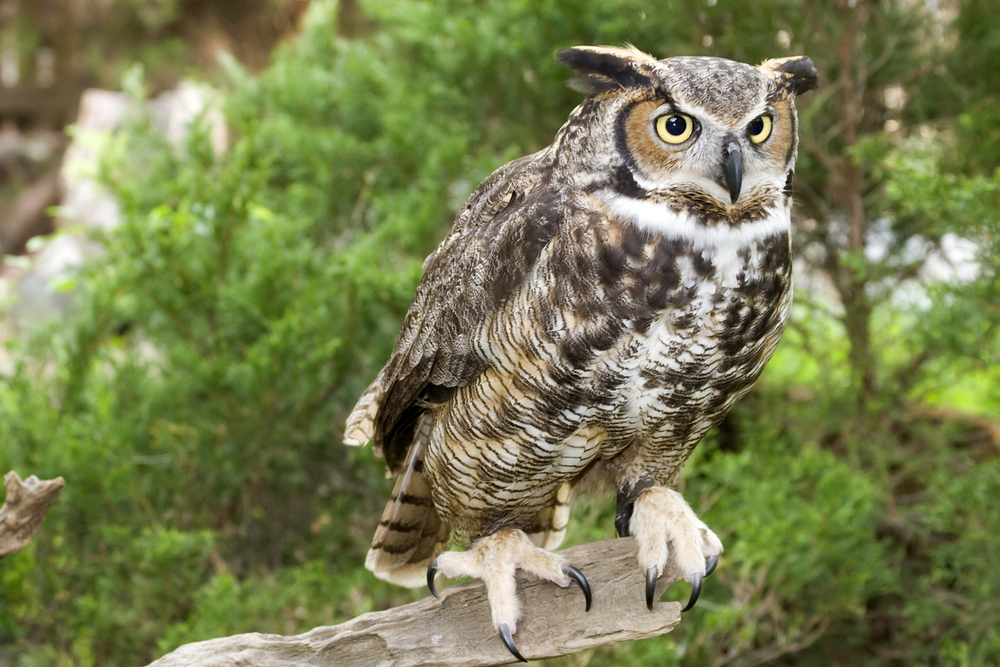
The Great Horned Owl is a simply gorgeous bird, and once you know how to identify it, you’re not likely to forget. Great-horned owls are best known for the two tufts of feathers on their heads that resemble horns or ears. Hence the name, Great Horned Owl. These owls are the largest in Texas, measuring 2 feet in height, with a wingspan of up to 4 feet. They are responsible for the classic ‘hoot’ sounds from tales and lonely nights. You’re most likely to hear them when they’re the most vocal, in the fall and winter.
They breed in January, filling the night with hoots as they serenade each other. In the early spring, you might see some ugly-yet-adorable baby owls peeking from nests (particularly abandoned hawk nests) atop trees or on rock ledges. These owls prefer woods and swamps, but can also be commonly found in the suburbs, if you look!
These owls are fearsome predators, going after anything their size or smaller. This includes squirrels, gophers, rabbits, even skunks, and other birds.
Great Horned Owls are a mottled gray-brown, with reddish-brown faces, and a white patch on their necks. They have a fierce gaze that’s sure to scare any prey stiff.
- Length: 18-25 inches
- Weight: 3-4 pounds
- Wingspan: 4.6 feet
2. Barn Owl (Tyto alba)
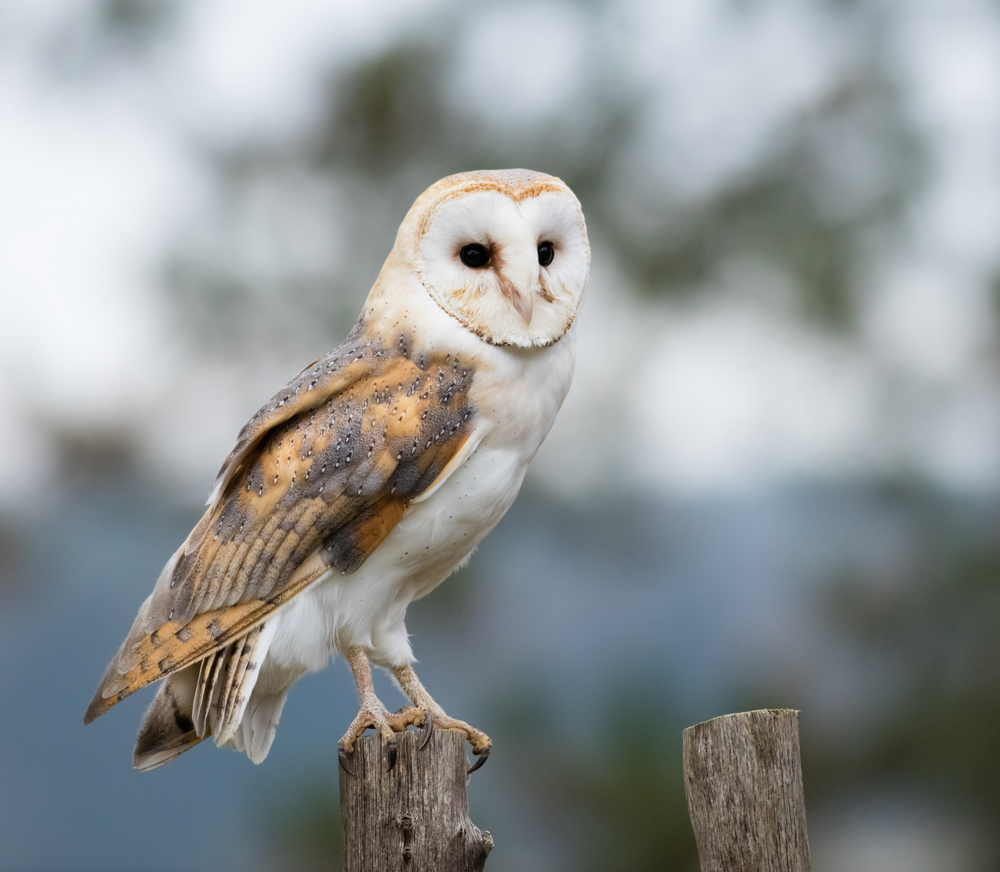
The Barn owl is one of the most visually striking owls, with a pale, heart-shaped face and wide, black eyes. Some find their faces unsetting, as they can appear bright and ghost-like in the dark. Others find them extraordinarily beautiful, with their golden backs and mottled tawny-gray feathers. When they are in flight, they are silent, graceful, and swift.
Barn Owls breed year-round and can be found in Texas all year. Like many owls, they are strictly nocturnal. You might hear their eerie, drawn-out screeches and see them flying overhead at dusk.
These owls will make themselves at home in chimneys, church steeples, and haylofts (likely how they got their name).
Despite their rather large size, Barn Owls are quite shy. If you approach one, it is unlikely to display any hostility, even if its nest is nearby, and will likely fly off.
- Length: 13-15 inches
- Weight: 1 pound
- Wingspan: 3 and ½-4 feet
3. Eastern Screech Owl (Megascops asio)
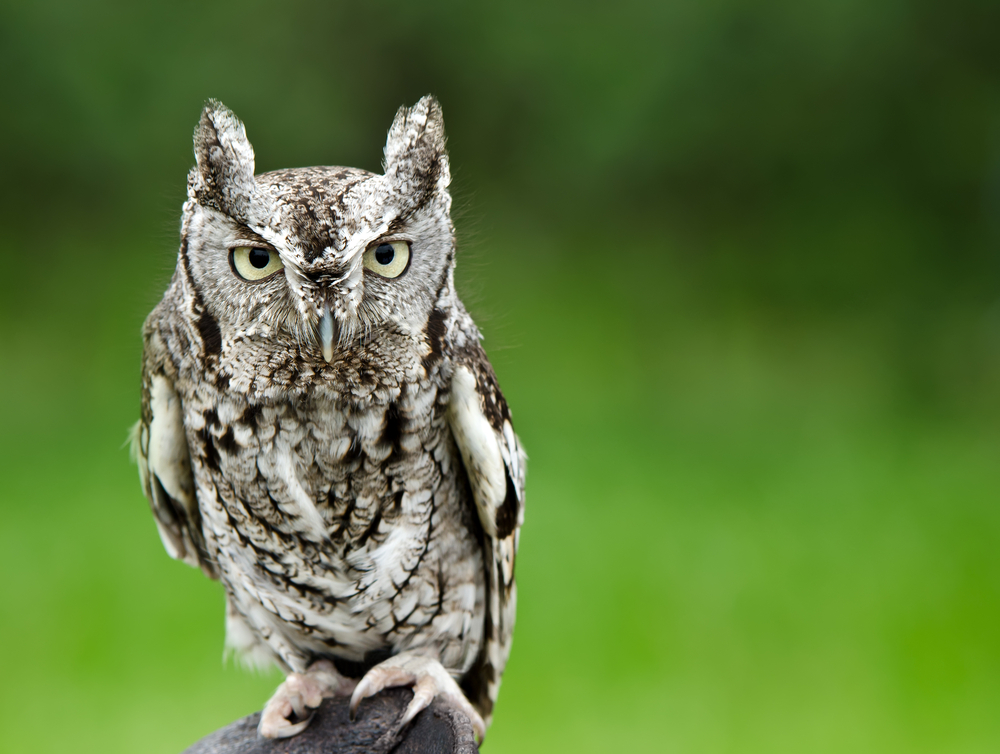
Eastern Screech Owls inhabit the Eastern forests of Texas, living in woodlands, clearings, and even parks and the suburbs (if you have a tall tree, once could even roost there).
These owls are fairly small, at only 6 inches on average, and they’re never seen out during the day. They are one of the most nocturnal owls in Texas, and you’re much more likely to hear than see them as they pass by in the dark!
Eastern Screen Owls come in two color variations, red morph (rufous) and gray morph, and in one brood, both can occur. They have ear tufts, proportionally big heads, large, yellow eyes, and no perceivable neck.
There is, of course, a reason that this owl is called a screech owl. Its distinctive screech is also called a ‘whinny,’ and can often be heard when they hunt, just after nightfall.
Eastern Screech Owls are roughly the size of the robin, so their food is limited to nighttime bugs, small mammals, small reptiles, and when they bathe, they might nab a passing fish as a snack!
- Length: 8 inches
- Weight: 5.8 oz
- Wingspan: 21 inches
4. Barred Owl (Strix varia)

Barred owls are round, short-tailed, stocky owls. They have smooth, tuftless heads, and big, almond-shaped dark brown, nearly black eyes. No doubt because of their similar eyes, they are sometimes mistaken with Spotted Owls or Barn Owls (despite the marked difference in feather color).
These owls have pale, heart-shaped faces, also somewhat like the Barn Owl. With their large, knowing eyes and gray faces, Barred Owls have a very wise and venerable look! In fact, they are very curious birds, and will likely observe you from afar. The coloration of the Barred Owl is the most remarkable, however, with white and brown checkering their back.
Barred Owls are most common in Eastern Texas, and reside in mature forests of deciduous and evergreen, where they compete with the threatened Spotted Owl.
They eat squirrels, chipmunks, mice, small reptiles, and even birds (up to the size of a grouse).
- Length: 19-20 inches
- Weight: 1.6 pounds
- Wingspan: 43 inches
5. The Western Screech-Owl (Megascops kennicottii)

Like their close relatives, Western Screech Owls have a very cute, round, stocky appearance. They have big, expressive eyes and small ear tufts, and they come in brown, gray, or reddish (rufous). Western Screech-Owls will also have gray streaks on their abdomens, and their bills are small and black.
These owls reside in the Trans-Pecos, as well as eastward, on top of the Stockton and western Edwards plateaus and forest, until they meet up with the Eastern Screech Owl.
If you see one of these little guys, you might only see their yellow eyes, while the rest of their body blends in with tree bark. Western Screech-Owls have excellent camouflage, and they love to live in trees, from which they can secretly peer!
Because they are so small, Western Screech-Owls are limited to small rodents, reptiles, and bugs. They mostly hunt at night, and you might hear their distinctive, screeching call. If you’re extra lucky, you might even see them flashing by overhead in the dark!
- Length: 7.5-10 inches
- Weight: 5.8-6.5 oz
- Wingspan: 22 inches
6. The Elf Owl (Micrathene whitneyi)
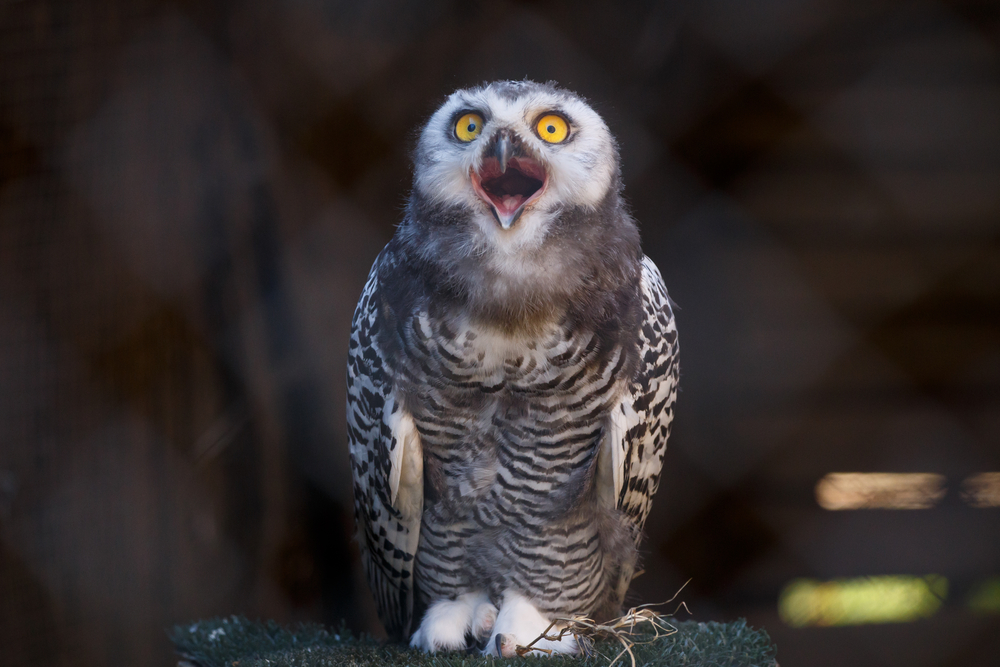
The Elf Owl is named for its diminutive size, and at only 6 inches, it’s the smallest North American Owl. This means it is not much larger than the common sparrow!
These adorable, tiny owls can be found in arid and dry areas in West and South-Western Texas, including the Chihuahuan desert (the lower half).
Here, they live in holes left behind by Ladderback Woodpeckers. These are often made in telephone poles, fence posts, and yucca stalks, as in the desert, trees are few. Bugs and small reptiles are the primary fare available to the Elf Owl.
Besides the fact that these owls are super-mini, you can also distinguish them by a v-shaped white stripe above their eyes, as well as their lack of ear tufts, their buff (yellow-pink) colored belly, and the reddish-brown color of their wings and back.
Elf Owls make yelping and chirping sounds, which begin around dusk. To glimpse one of these little guys, you’ll need a sharp eye and ear!
- Length: 5.5-6 inches
- Weight: 1.2-2 oz
- Wingspan: 10.5 inches
7. The Ferruginous Pygmy-Owl (Glaucidium brasilianum)
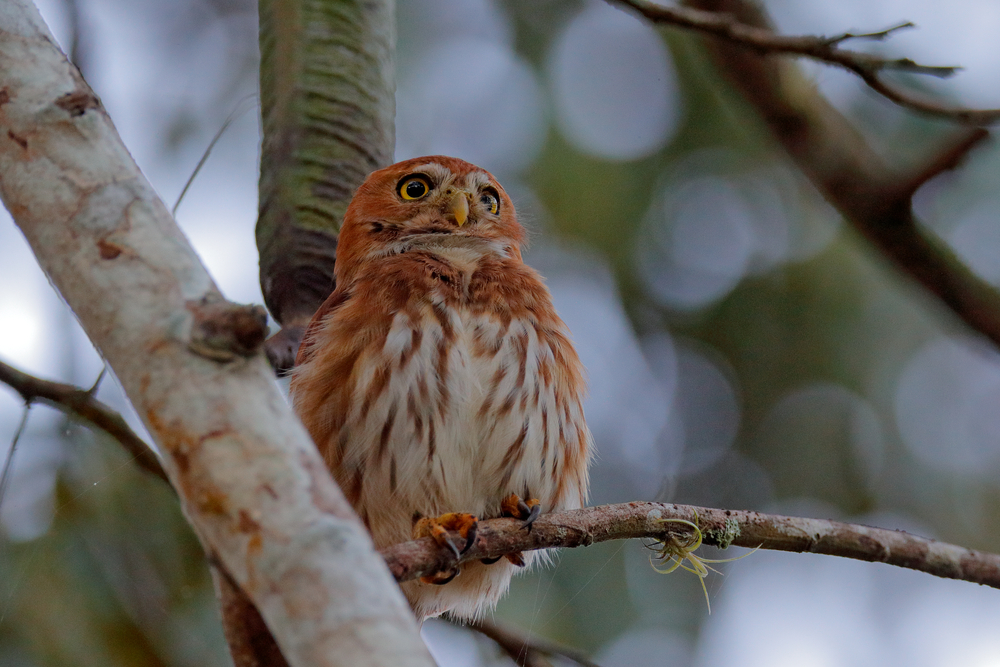
The Ferruginous Pygmy-Owl is somewhat unique in that it can be observed out and about during the day. Most owls are limited to after dark.
These owls reside in Southern Texas, which best suits their preferred tropical environment, all year. In most areas of Texas, they are uncommon to considerably rarer. To see one, you’ll need a healthy dash of luck!
The Ferruginous Pygmy-Owl gained its name from its exceptionally small, 6.5-7-inch tall stature; only the Elf Owl is smaller!
This owl species in Texas is typically a striated brown and white or brown and gray in color, with their belly being much whiter than their back. They also have white-streaked crowns, and some sport white ‘eyebrows.’ Their heads are smooth and round, and their eyes are a striking yellow color.
Due to their size, Ferruginous Pygmy-Owls subsist mainly on insects, particularly grasshoppers, as well as scorpions, small reptiles, and even some smaller birds, like the Eastern Meadowlark!
- Length: 6.5-7 inches
- Weight: 2.2-2.7 oz
- Wingspan: 14.5-16 inches
8. The Burrowing Owl (Athene cunicularia)
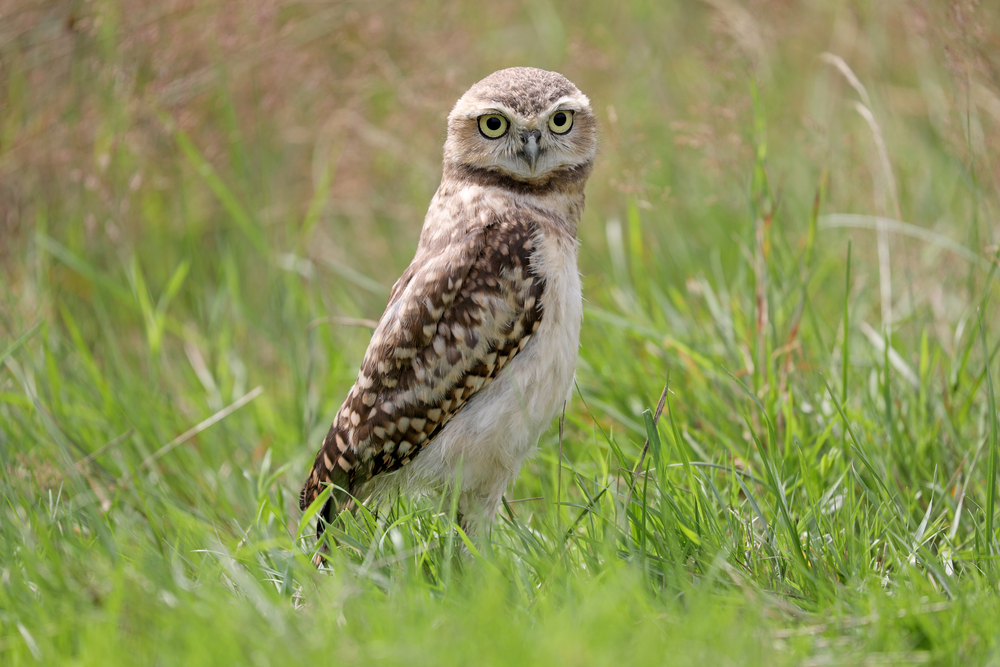
In Western Texas, and the panhandle area, we have the Burrowing Owl. This owl is active day and night, and can be found in meadows, fields, pastures, and anywhere else you’d find holes and dens underground. This is because Burrowing Owls make their nests in the homes that burrowing animals have left vacant. So, in reality, all that the Burrowing Owl needs to do is a bit of digging to upkeep, rather than doing the excavation itself.
Burrowing Owls have bright yellow eyes and are usually sandy-brown in color, although they can be darker or lighter. They also have super-long legs that allow them to cover ground quickly, or to pop their head out of their burrow to check for danger!
When it comes to food, they consider insects and small rodents to be an excellent snack!
- Length: 10 inches
- Weight: 6 oz
- Wingspan: 20-24 inches
Non-Native or Endangered Owls in Texas
These are owls that are non-native visitors to Texas, or endangered, making them considerably rarer. It’s still possible to spot one of these, if you know how to look!
9. The Long-eared Owl (Asio otis)
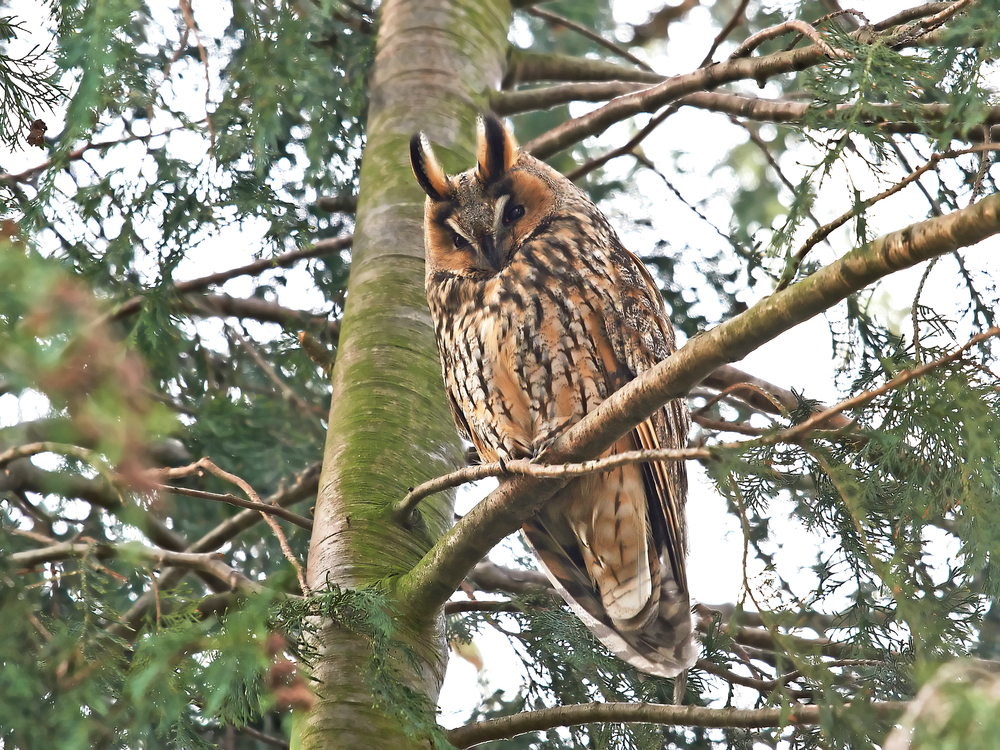
The Long-Eared Owl is most recognizable by the long feather tufts on its head, or ‘long ears.’ Sightings of them are rare, as they do not breed in Texas, but they have occasionally been observed in the Northern regions. Sometimes mistaken for the Great Horned Owl, with their similar ear tufts, the Long-eared owl is actually roughly a foot smaller. Long-eared Owls also have distinctive orange facial discs, and compared to Horned Owls, their ‘ear’ tufts are closer together!
Long-eared Owls communicate with a series of low hoots, and are also known to meow. They hunt at night, and fly close to the ground in search of rodents, their hapless prey.
Long-eared Owls have a marked preference for woodland, especially pines, where they perch near the trunk. They borrow abandoned nests from other birds for just over 2 months, until their hatchlings are ready to take off.
- Length: 14 inches
- Weight: 8-15 oz
- Wingspan: 35-40 inches
10. The Flammulated Owl (Psiloscops flammeolus)
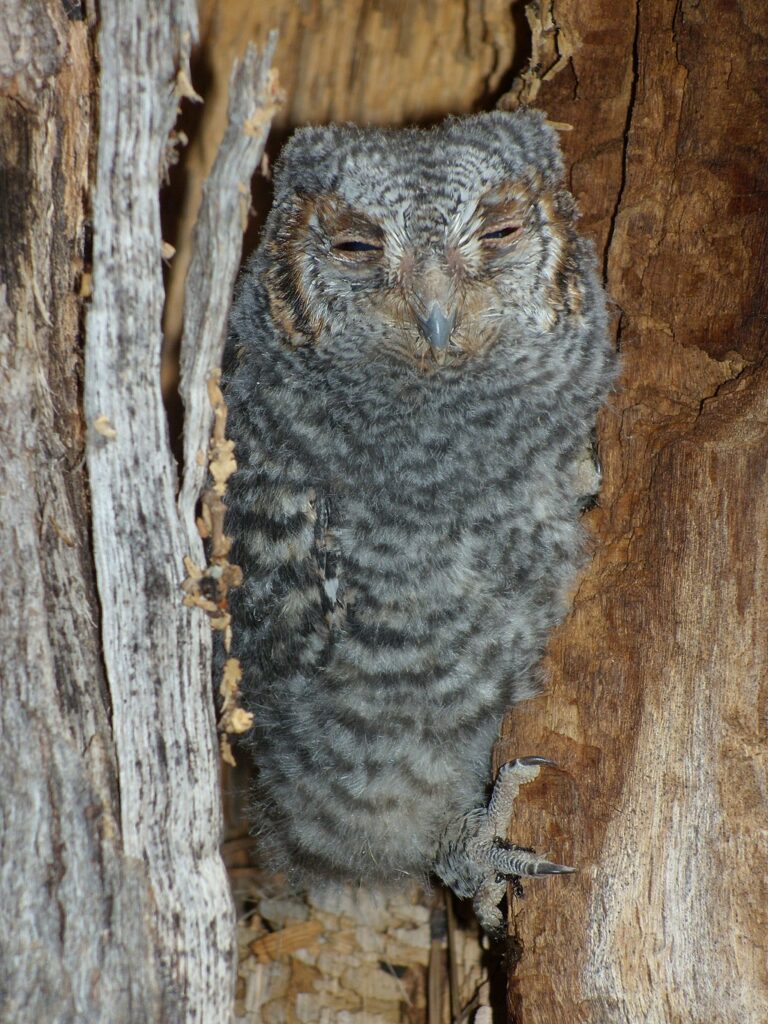
The Flammulated Owl is named for the flame-like patterning on its feathers, which among birds is known as being ‘flammulated.’ Indeed, the Flammulated Owl has reddish-markings that are reminiscent of flames, and cracked embers. Aside from this, they are mostly a light, dusky gray or brown, with some stripes that are darker.
Their eyes are quite round, and entirely black.
The flammulated appearance of this owl is not only beautiful, it also provides remarkable camouflage, aiding them as a night hunter. Sadly, it does make sightings even rarer!
These little owls are most comfortable in coniferous forest treetops, where they blend in smoothly with the bark. Surprisingly for their small, only 6-inch size, their hoots are rather powerful, and pitched quite low!
- Length: 6 inches
- Weight: 1.8-2.3 oz.
- Wingspan: 14 inches
11. The Short-eared Owl (Asio flammeus)
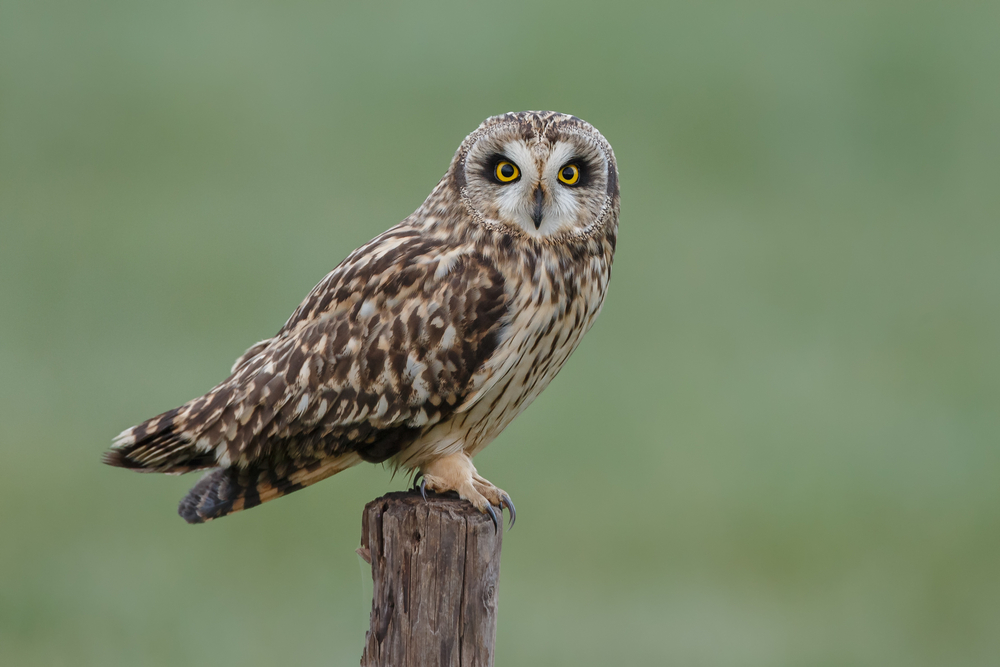
The Short-eared Owl is not generally seen in Texas in the spring-fall, but may make an occasional appearance in the winter. These owls are fond of grasslands, meadows, and large, natural forest clearings. The Short-eared Owl will hunt mice, rats, voles, shrews, and even smaller birds, and is an opportunistic eater. These owls are not particularly vocal, hooting occasionally, and barking or screaming to scare predators off.
The Short-eared Owl owl has a round head, short neck, tawny or sandy belly, and a light or dark brown back. Their faces are light, with bright yellow eyes, they possess no ear tufts, and their feathers have a uniquely ruffly look. They can be seen flying low over fields in the fading light, their motions moth or bat-like (not to be mistaken with the similar-looking Harrier).
- Length: 13-17 inches
- Weight: 7.3-16.8 oz
- Wingspan: 33-44 inches
12. The Snowy Owl (Bubo scandiacus)

The Snowy Owl is native to the arctic tundra, and they are very rare in Texas. They can show up once in a blue moon in the North, however!
These gorgeous birds are popular world-wide for their exotic look. They are quite large, at over 2 feet, with a wingspan of 4-5 feet. They are a magnificent sight, enormous birds with bright yellow eyes and pure white feathers, barred with brown or black.
Their preferred fare of Snowy Owls are lemmings, but they will also eat rabbits, fish, rodents, and smaller birds.
While Snowy Owls are not the most vocal, they can hoot, hiss, and whistle, when they are faced with potential danger!
- Length: 2.1-2.4 feet
- Weight: 4.5 lbs
- Wingspan: 4-5 feet
13. The Spotted Owl (Strix occidentalis)
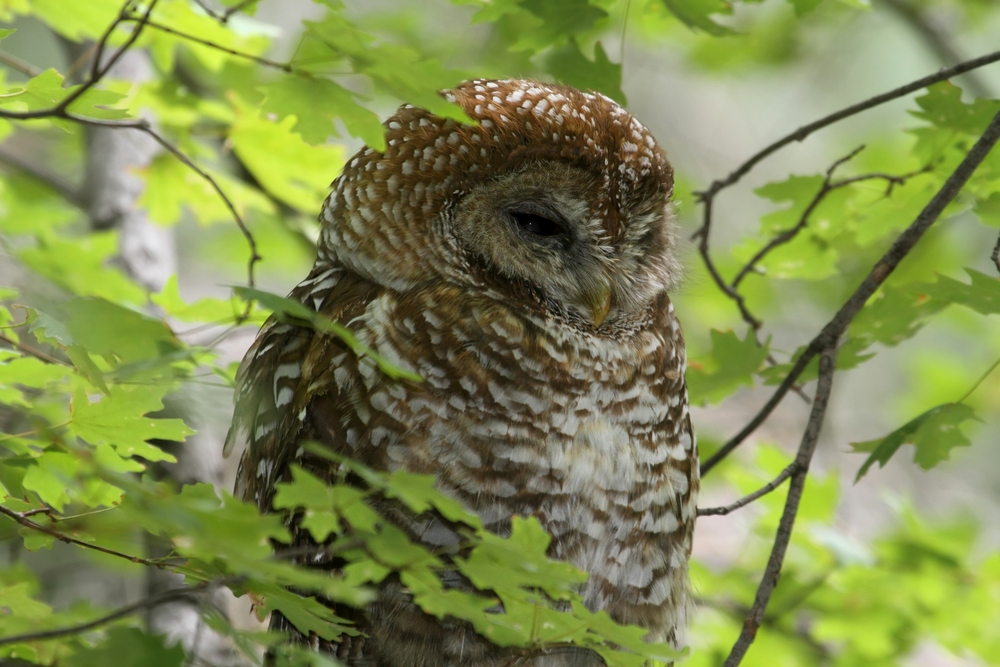
The Spotted Owl is so named for the white and brown spots on their abdomen, head, and back. They are a dusky-chestnut brown color, and their eyes are uniquely all-black (like the Barn Owl).
Spotted Owls are limited to the Western forested regions of Texas and have been becoming scarcer. This is due to deforestation and competition for territory with the Barred Owl. You might still spot one while you’re camping in the forest at night, with a little luck!
While Spotted Owls will mostly eat small rodents, such as mice, voles, and squirrels, they are also known to eat small reptiles, bats, and even small birds (including woodpeckers).
These owls prefer habitats in elevated, cool locations, such as trees and cliff nests that are 5,000-7,000 feet. They favor white pine and Douglas fir.
- Length: 1.5 feet
- Weight: 1.3 lbs
- Wingspan: 4 feet
14. The Northern Saw-whet Owl
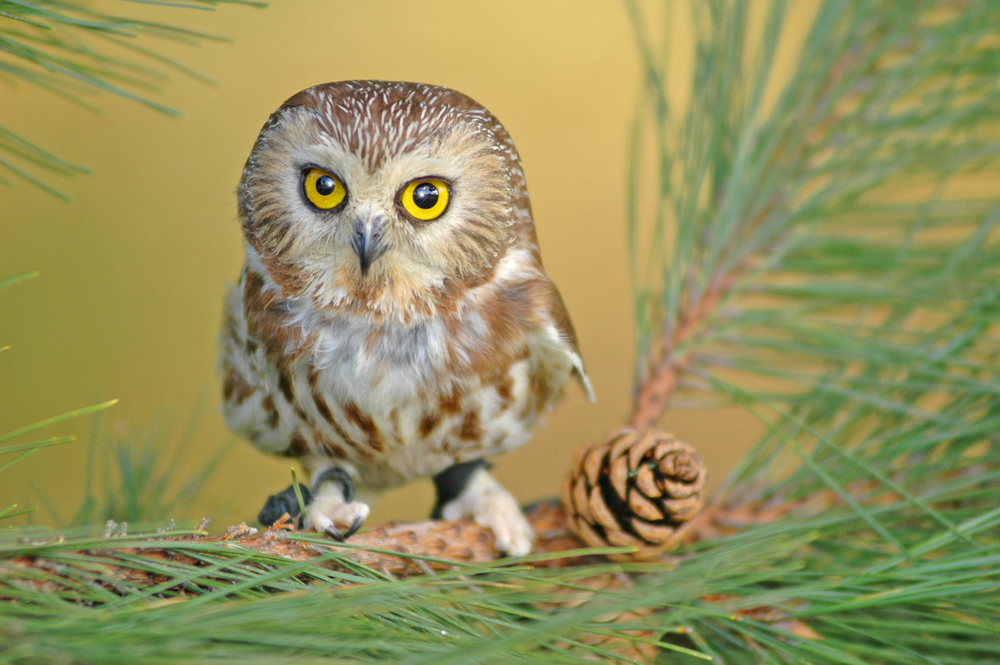
The Saw-whet Owl is named for one of its most unusual vocalizations, a scraping sound that resembles that made by the sharpening of a saw! Normally, they make a series of soft hoots, saving their ‘saw-whet’ sound to warn of danger.
These little guys are most at-home forests and woodlands, particularly coniferous forests full of pine and fir. They often move into holes that have been made, used, and vacated by woodpeckers, most notably the Northern Flicker.
In Texas, it is rare, but not impossible, to glimpse a Northern Saw-whet Owl. These little owls rarely exceed 7-8 inches, with dark-brown backs, white eyebrows, and faces that are light brown in color. They eat a variety of rodents, and Deer Mice are a favorite snack!
- Length: 7.1-8 inches
- Weight: 3.6 oz
- Wingspan: 16.5-18.9 inches
Final Thoughts
Did you know how many owl species in Texas there were? Not only are there a handful of native residents, several non-native species may also visit throughout the year. Each of these has a uniquely beautiful plumage, and each was born and bred a hunter!
There are owls from the size of a large predatory bird, to those that are as small as a sparrow. Some hoot, some whistle, and some meow. Owls eat rodents, reptiles, even scorpions, lemmings, and smaller birds. These fascinating, nocturnal birds are all over in Texas – you’re sure to catch sight of one eventually, if you take the time to look!
